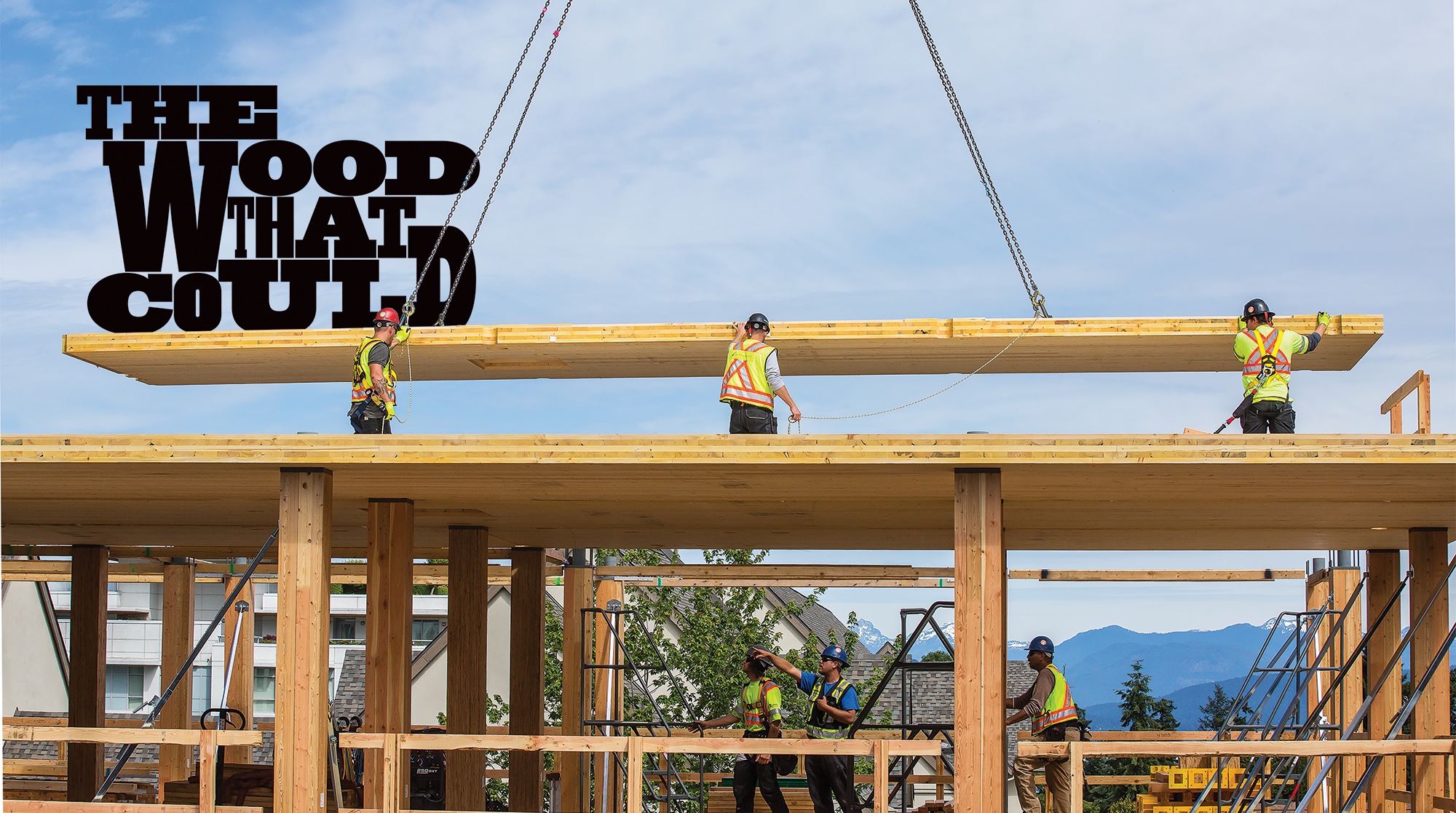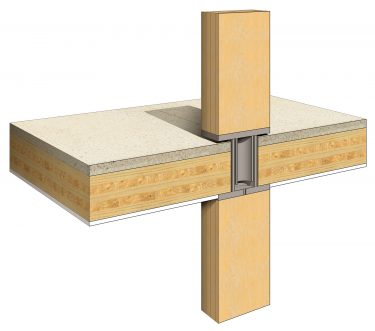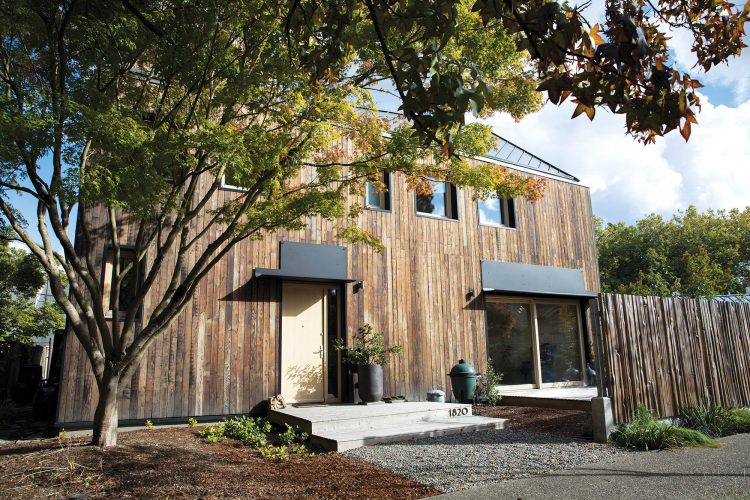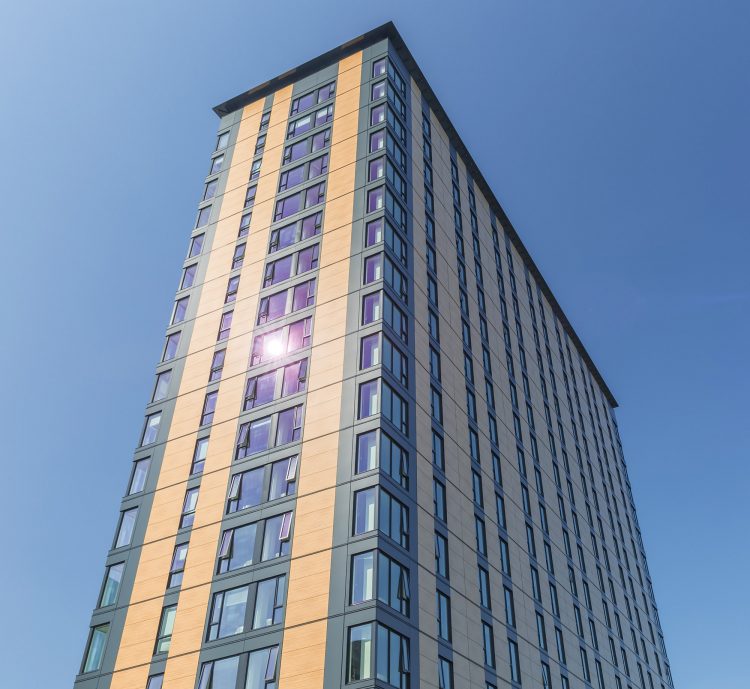

Trees line the Madison Park neighborhood that Susan Jones calls home. A big vine-leaf maple shepherds guests to her front walk. This block is an urban forest, a blend of trees and concrete, Douglas fir siding, and cedar-and-steel fences. It’s Mother Nature and architectural marvels.
Jones’ home fits right in—and not just because the two-story abode features vertical warm wood paneling and sharp angles. What you can’t see is that this home is constructed of cross-laminated timber (commonly referred to as CLT), a next-generation forest product that promises to revolutionize forest management, economic growth, architecture and the construction industry. And that’s just for starters. Its real superpower? The ability to sequester carbon from the atmosphere.
Jones, founding architect of the Seattle-based firm atelierjones and a UW associate professor of architecture, envisioned using cross-laminated timber when designing her two-story house. Built in 2015, it is one of the nation’s first residential projects constructed primarily of the material. Sometimes described as “plywood on steroids,” cross-laminated timber was developed in Europe in the 1990s and is widely used throughout the U.K., Australia, Canada and Japan. It is gaining momentum in the U.S. as regional leaders, including the UW, advocate for broader use.

Cross-laminated timber
“For me, this house is an immersion into nature,” Jones says. “The CLT helps creates a peaceful, serene setting that takes away stress.” Garden beds line Jones’ rooftop deck. Dozens of Western Red Cedar seedlings sprout upward. Last autumn, Jones gathered cedar cones during her walks across the UW campus and planted them at home.
“It’s a mini-forest now,” Jones says, fanning the needles with her fingers. “I imagine them 50 or 100 years from now when they’re fully grown. They might contain enough wood to build this house all over again.”
While not every cross-laminated timber building grows actual trees, the material itself is a potential game-changer for forest health and management. To make cross-laminated timber, three to nine layers of wood are stacked perpendicularly, compressed and then bonded together. Wood planks can be small; in Europe, one-inch-thick planks are being made, meaning that small-diameter trees can be used. Another advantage of the new process is that less desirable lumber grades, including those damaged by pests and those already dead, can be used without compromising the panel’s overall integrity.
“The basic idea of gluing pieces of wood together isn’t that radical,” says Bernard Bormann, director of UW’s Olympic Natural Resources Center and professor of forest ecology and physiology. “The concept has been improved, that’s the real difference. These CLT panels are so incredibly strong.” Finished panels can be as large as 18 by 98 feet, with the average length in the 40- to 60-foot range.
To make cross-laminated timber, three to nine layers of wood are stacked perpendicularly, compressed and then bonded together.

The Madison Park home of architect and UW professor Susan Jones is one of the nation’s first residential projects built with cross-laminated timber. (Photo by Erin Lodi)
This new building material also offers advantages beyond its strength. It “creates a new market for less-than-perfect boards and is a better utilization of existing resources,” Bormann explains. By opening up new supply fronts, CLT aids sustainable forestry. And because CLT manufacturers can harvest small and already-dead trees, tree-thinning becomes a profitable endeavor.
“On the east side of the Cascades and the Olympic Peninsula, we’re seeing forest fires every summer,” says Ivan Eastin, director of the UW Center for International Trade in Forest Products (CINTRAFOR) and associate dean for research in the College of the Environment. “Generally, those areas are in poorer conditions and in need of thinning. Pulling out small- and medium-sized timber would actually contribute to healthier forests.”
According to Bormann, excessively dense stands of trees block light and reduce habitat quality. Thinning benefits both wildlife and the growth of existing, hardier trees. “CLT has potential to forge new links between lands and people,” says Leda Chahim, who until recently was government affairs director for Forterra, a Northwest nonprofit focused on land preservation. “It can potentially make headway toward healthier and more resilient forests, particularly on our public lands. It’s an exciting new option.”
•••
As a child, Jones visited the beach cabin her grandparents built on Orcas Island. The family took the ferry and cozied into the rustic abode for holidays. Crossing the threshold into that warm wood interior made a lasting emotional impact on Jones, and served as the inspiration for her Madison Park home. “It’s something I want more people to experience. Our urban and natural environments are often so separated,” Jones says. “Living more healthfully by using natural, renewable materials like CLT is an exciting, wholesome, peaceful prospect.”
There is another exciting prospect, too: the mere act of using cross-laminated timber to build will benefit the environment in other substantial ways. “Our (UW) research indicates that using more CLT expends less energy than producing and transporting traditional building materials, such as concrete and steel,” says Indroneil Ganguly, associate director of the UW-CINTRAFOR and assistant professor in the School of Environment and Forest Sciences.
“The basic idea of gluing pieces of wood together isn’t that radical. The concept has been improved, that’s the real difference. These CLT panels are so incredibly strong.”
Professor Bernard Bormann, director of UW’s Olympic Natural Resources Center
CLT not only emits less carbon dioxide during the manufacturing phase but the finished buildings made with CLT helps sequester existing carbon for a longer period. “Buildings made with CLT for structural applications result in around a 25 to 30 percent reduction in global warming potential compared to a similar building built with traditional materials.”
Eastin cites a building in London as a compelling example. It is called Murray Grove, and it is the first tall urban housing project to be constructed entirely from cross-laminated timber, from the load-bearing walls and floor slabs to the stair and lift cores. “It’s carbon negative from the start. It will take 21 years before the building will even reach carbon neutrality,” Eastin says. “If they’d used concrete, 137 tons of carbon would have been generated just to build it.”
CLT’s benefits even extend to end-of-life disposal. Tearing down and disposing of a CLT building results in 50 to 80 percent less global warming potential, as compared to end-of-life disposal of a building made with traditional building materials. “It’s important to use CLT and demonstrate the benefits of building more sustainably,” Jones says. “Climate change is one of the most important issues of my generation. One day, I want to tell my grandchildren that I did whatever I could in my own small way.”
On the architectural front, CLT lends itself to unique opportunities. The front edge of Jones’ home comes together like a ship’s prow. The bedroom ceiling joins three panels like the point of a treetop. Due to their strength and manufacturing to specifications, CLT panels can be fabricated with unusual angles to create spaces that respond to light and views in beautiful ways. While not impossible using traditional construction methods and materials, it would be more challenging and expensive.
CLT is also reaching greater heights when it comes to size. Currently, the University of British Columbia is home to the world’s tallest CLT building. Brock Commons, a student residence, is 174 feet high. The 18-story dorm houses more than 400 students. Timber high-rises are also sprouting up across Europe. Vienna’s 24-story HoHo Tower is currently under construction and will be 76 percent wood. Paris’ 35-story Baobab building is in the works. The most ambitious proposal to date is London’s timber-framed, 80-story Oakwood Tower.
CLT is amazingly fire-resistant. The outer layer burns and chars, which insulates inner layers and prevents the core from catching fire.
“From the architectural and building perspectives, the technical advantages of using CLT are enormous. It’s transformational,” says Eastin, the associate dean for research at the College of the Environment.
He estimates that a CLT project can reduce construction costs by up to 50 percent and speed up construction times as much as 65 percent. Because it’s a lighter material, CLT requires smaller and less expensive building foundations. Panels can be quickly and efficiently assembled on site, which reduces construction cost, labor and the amount of trucks, noise and neighborhood disruption.
While the use of CLT is catching fire, the material itself is amazingly fire-resistant. Eastin describes it as “basically self-extinguishing.” The outer layer burns and chars, which insulates inner layers and prevents the core from catching fire.
We know the benefits cross-laminated timber can bring. So how does it become mainstream? A primary goal for U.S. advocates of cross-laminated timber, including those at the UW, is educating the broader community and training the next generation of those who design, create and make buildings. “One of the main things we now need to do at the universities is teach architects, engineers and builders more about designing with CLT wood,” says Eastin. “It has different properties and people have to understand how to use it effectively.”
One area that needs to account for this new product is building codes. In the city of Seattle, most codes generally cap traditional wooden structures at six stories. Nevertheless, the use of CLT is expected to increase. Ganguly published a 2017 study that forecast Northwest demand over the next 20 years. (It is increasing.) Jones sits on a national committee, the ICC Tall Timber Committee, to change U.S. Building Codes to allow tall timber buildings up to 18, even 20 stories. Once these codes are implemented sometime in the 2018 Code Cycle, demand is expected to jump significantly.
Education and collaboration are the next steps to making more people aware of CLT and its incredible advantages. Currently, there are two UW proposals to establish centers for CLT research and education—a Center for Wood Innovation and the Center for Innovative Wood Products. Proposed efforts include support from the College of the Environment, Department of Architecture plus the College of Built Environments.
“The research and work provided by UW has been key,” says Chahim, the former government affairs director for Forterra, the nonprofit that focuses on land preservation. “Their advice and advocacy has been critical to the regional conversations surrounding CLT. It has influenced the thinking and understanding about potential opportunities for use and the impact on forests.” Through the UW Department of Architecture, Jones has taught two studio courses comprised of graduate students over the past four years. Their UW studios have self-published two books on the work, and her office, atelierjones, has held an exhibition of their CLT work on the UW campus. Jones’ own book on atelierjones’ Mass Timber design and research will be published in December 2017 with ORO Editions.
“UW students are involved with CLT in live time,” Jones says. “We’re exploring these issues together regarding the technical, aesthetic and even regulatory points of view. They love learning about it, breaking new ground and their passion is infectious.”
An open-slat wooden fence surrounds Jones’ home. The cedar planks originally staked pea vines on her family’s Skagit Valley farm in the 1940s. Individually, they are weathered with age and time has whittled them to branches. However, much like CLT, their sum is greater than their parts. Everything old is new again. “It’s about using materials in a thoughtful way and not taking them for granted. That’s what I love about CLT. It’s a testimony to taking something imperfect and making it valuable again,” Jones says.

Brock Commons rises 174 feet into the Vancouver sky from the grounds of the University of British Columbia. At 18 stories, the student residence is the world’s tallest building made from cross-laminated timber. (Photo courtesy of the University of British Columbia Public Affairs)
That approach might extend to the Washington forest industry. Until 1940, the Evergreen State was the nation’s leading timber producer. But over the decades, economic recessions and environmental protections decreased logging on federal lands. In 1990 alone, more than 50 Northwest saw mills closed. “In the past decades, timber production from national forests dropped close to 90 percent,” says Bormann. “In addition to policy changes, there were technological advances in mills that reduced jobs and it all contributed to a major crash of the local timber industry.”
The hope is that CLT can help resurrect the industry, boosting rural job growth while creating an environmentally sustainable source to support the state’s economic future. By harvesting smaller and even damaged timber, CLT could renew logging interest in both new and long-overlooked forests. But there are barriers. Washington does not yet have a commercial production facility, though some experimental equipment is in place at two locations in Eastern Washington. However, demand has galvanized current mills to expand. And the outlook is favorable for new facilities to come online.
Vaagen Brothers Lumber, a fourth-generation Washington timber company, is set to embrace CLT in 2018 by expanding its operations in Colville. California-based Katerra is on track to open a plant in the Spokane Valley next year and employ upward of 150 people. Local production facilities will likely lower the retail price of CLT by eliminating the need to import. “The huge upside for the Northwest is that we’re one of the best places on the planet to grow trees,” says Rep. Steve Tharinger, chair of the Washington State House Capital Budget Committee. “CLT could be an environmentally sensitive way to use those resources.” Tharinger’s district represents the Olympic Peninsula, Clallam and Jefferson Counties plus most of Grays Harbor County, areas that were devastated when the timber industry fell on hard times.
“We have affordable housing needs in the state, which are acute in the Puget Sound area,” Tharinger continues. “CLT can help meet some of the urban growth needs while creating jobs in the rural areas. It’s a win-win.”
Brian Hatfield, who leads the forest products sector for the state’s Department of Commerce, believes CLT can also address unique housing needs in sparsely populated regions of the state. With few home builders in their communities, residents in Klickitat and Pacific counties rely on manufactured housing. Instead, says Hatfield, “CLT could be perfect for those who want a solid, sturdy structure, but still need something that comes together quickly and doesn’t require as much construction infrastructure.”
Tharinger cites school construction as another arena where CLT can make a big difference. There is a statewide need for new schools at all levels, but funding often falls short. CLT, with its faster construction times and lower costs, could make this a more viable option. The state’s 2016 budget allocated $5.5 million for a pilot program to build 20 modular-classroom buildings in five school districts. Greywolf Elementary in Sequim has already been completed using timber from the Olympic Peninsula, as has atelierjones’ two CLT modular schools in Eastern Washington.
“The schools are really excited,” Tharinger says. “What we did with the school construction has helped develop the market and successfully showcase what this material can do.”
Part of what excites UW’s CLT advocates is the opportunity to collaborate and highlight how their work and research can be harnessed statewide. UW Tacoma, in partnership with Forterra, hosted the third annual Cross-Laminated Timber conference in November 2017.
“There is a strong commitment by everyone at UW to make our work relevant to all of Washington and help people across the state,” Bormann says. “CLT is a beautiful bridge to help bring everyone together around something benefiting all of us.”